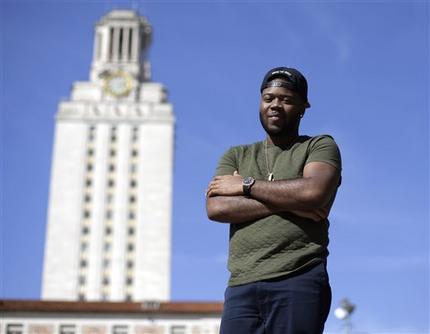WASHINGTON (AP) — Has the nation lived down its history of racism and should the law become colorblind?

In one case, the issue is whether race preferences in university admissions undermine equal opportunity more than they promote the benefits of racial diversity. Just this past week, justices signaled their interest in scrutinizing affirmative action very intensely, expanding their review as well to a Michigan law passed by voters that bars “preferential treatment” to students based on race. Separately in a second case, the court must decide whether race relations – in the South, particularly – have improved to the point that federal laws protecting minority voting rights are no longer warranted.
The questions are apt as the United States closes in on a demographic tipping point, when nonwhites will become a majority of the nation’s population for the first time. That dramatic shift is expected to be reached within the next generation, and how the Supreme Court rules could go a long way in determining what civil rights and equality mean in an America long divided by race.
The court’s five conservative justices seem ready to declare a new post-racial moment, pointing to increased levels of voter registration and turnout among blacks to show that the South has changed. Lower federal courts just in the past year had seen things differently, blunting voter ID laws and other election restrictions passed by GOP-controlled legislatures in South Carolina, Texas and Florida, which they saw as discriminatory.
“Whenever a society adopts racial entitlements, it is very difficult to get out of them through the normal political processes,” Justice Antonin Scalia said in oral arguments earlier this year, suggesting that it was the high court’s responsibility to overturn voting protections overwhelmingly passed by Congress in 2006.
Justice Ruth Bader Ginsburg, part of the court’s more liberal wing, countered that while conventional discriminatory tactics may have faded, new ones have emerged. “Congress said up front: We know that the (voter) registration is fine. That is no longer the problem. But the discrimination continues in other forms,” she said.
The legal meanings of “equality,” `’racism” and “discrimination” have been in flux since at least 1883, when justices struck down a federal anti-discrimination law, calling it an unfair racial advantage for former black slaves. Today, justices face the question of whether the nation has reached equality by a 1960s definition or some new standard.
By some demographic measures, America has reached a new era. But the latest census data and polling from The Associated Press also show race and class disparities that persist.
President Barack Obama, the nation’s first black chief executive, was re-elected in November despite a historically low percentage of white supporters. He was aided by a growing bloc of blacks, Hispanics, Asian-Americans and gays, and a disproportionate share of women, who together supported him by at least a 2-to-1 margin.
Another sign of shifting times: Among newborns, minorities outnumbered whites for the first time last year, the Census Bureau reported. “The end of the world as straight white males know it,” one newspaper headline said on the morning after the November election.
Still, issues linger by race, age and class:
-Jobs and income. Black poverty has fallen by half since 1959, to 27.6 percent, but is still nearly three times the poverty rate of whites. Black and Hispanic men are twice as likely as whites to work in the low-paying service sector. Since the 1970s, the unemployment rate for blacks has remained double that of whites.
-Wealth. The wealth gap between whites and minorities is at its widest since 1984. Predominantly younger minorities were hit hard when home prices fell, while older whites were more likely to invest in 401(k) retirement plans and stocks, which have rebounded since the recession. The median net worth of white households was $113,149 in 2009, compared with $6,325 for Hispanics and $5,677 for blacks.
-Class and education. By some measures, the gap between rich and poor has stretched to its widest since 1967. Globalization and automation have eliminated many mid-skill jobs, leaving a polarized pool of low-wage work and high-skill jobs requiring advanced degrees. About 40 percent of whites age 25-29 graduate from college, compared with 15 percent for Latinos and 23 percent for blacks.
-Racial bias. Prejudice against blacks worsened slightly in the four years since Obama was first elected in 2008, according to an AP poll. In all, 51 percent of Americans expressed explicit anti-black attitudes, compared with 48 percent in 2008. Questions designed to ferret out subconscious bias raised the proportion with anti-black sentiments to 56 percent, and the share of people expressing pro-black attitudes fell.
Roderick Harrison, a demographer who is black, says he felt pride in Obama’s re-election, which to him reaffirmed a historic achievement not only for black Americans but also a broader coalition of racially diverse groups. Still, he worries that demographic change and Obama’s success may lead to a tipping point in the opposite direction, where people in the United States are led to assume racial equality has fully arrived.
The strength of minority support behind Obama was aided by the 1965 Voting Rights Act and other protections, he said.
The term “minority” often refers to an unequal or disadvantaged status and isn’t always about numbers or counts, said Harrison, a former chief of racial statistics at the Census Bureau. The District of Columbia, Hawaii, California, New Mexico and Texas already have populations of racial and ethnic minorities that collectively add up to more than 50 percent. Across the U.S., more than 11 percent of counties have tipped to “majority-minority” status.
“Minority status is a matter of exclusion from full participation in society, remaining long after a nation becomes `majority minority,'” Harrison said.
—
To Bradley Poole, 21, a senior at the University of Texas at Austin, racial progress is measured by the little things. An advertising major, Poole became a member and then president of the school’s Black Student Alliance, seeking camaraderie after noticing he often was the only African-American in his classes.
“I definitely feel the difference,” he said.
The university automatically grants admission to the top 10 percent of students in each of the state’s high schools. That helps bring in students of different backgrounds because Texas high schools are highly racially segregated, reflecting decades of segregated neighborhoods.
In a state where blacks now make up 11.5 percent of the population and Hispanics 38 percent, the university’s enrollment of 50,000 students never rose above 3 percent to 4.5 percent black and 13 percent to 17 percent Hispanic. So in 2004 it decided to allow students who miss the 10 percent cutoff to be considered for admission based on a range of socioeconomic factors, including race.
The share of black students has since increased slightly to 6 percent, while Hispanic enrollment rose to 26 percent.
The university’s affirmative action plan is being challenged in the Supreme Court by Abigail Fisher, a white student who missed the cutoff and was rejected. Fisher says she was denied fair consideration because of her race.
A 2003 Supreme Court opinion said universities may consider race only as one of several factors to promote diversity. The court said diversity benefits everyone because in a global economy it fosters leaders who can relate to people of different backgrounds.
In the last week, justices also agreed to take up a second affirmative action case this year, deciding whether states may pass laws that restrict the use of race preferences in college admissions. That case involves an appeal to a lower court ruling that found a 2006 voter-approved ban in Michigan unconstitutional, reasoning that such bans put minorities at a disadvantage.
The justices’ decision to hear the Michigan case next fall – with their decision in the Texas case still to be announced this spring – suggests that the court will not decide in the Texas case to eliminate affirmative action programs in higher education.
In the seven or so states that enacted bans on affirmative action at their public universities, freshman enrollments of blacks and Hispanics almost always fell afterward – as much as 50 percent at UCLA and the University of California, Berkeley – although in some cases they later rebounded. Those states now include Arizona, California, Florida, Nebraska, New Hampshire, Oklahoma and Washington. A Supreme Court ruling that further restricts affirmative action could shake up college admissions policies nationwide, perhaps shifting focus to low-income students or low-performing schools.
Before opting to enroll at Texas, Poole says he considered attending a mostly white university in Iowa and a historically black college in Louisiana. The college course he now values the most: an advertising seminar that he attended along with a Hispanic, a female student-athlete and an Asian-American. No one in that class was a “minority,” he said, and there was a range of perspectives.
Outside class, Poole says his organization has experienced racial incidents. One white student ran up in “blackface” to where members were gathered on campus, daring them to respond. A legal brief filed by the National Association for the Advancement of Colored People on behalf of Poole’s group lists other racial incidents in recent years, some of which led to suspensions or public apologies.
“Racial diversity is a conversation we need to have,” he said.
—
Not since the tumultuous 1960s have U.S. ideals of equality been more closely contested. Legal analysts say a Supreme Court holding of a colorblind Constitution, either as a matter of law or practical effect, could begin to emerge in two rulings on voting rights and affirmative action due out by late June. A third ruling in the Michigan affirmative action case will come next term.
The five conservative justices who make up a majority could overturn the 2003 opinion or take a less dramatic step. The court may opt for tighter restrictions that make it difficult for colleges to consider race or rule narrowly that in a situation like Texas, its unique top 10 percent plan is enough on its own to achieve diversity.
In the court’s other racial case, a conservative majority may declare the 1965 Voting Rights Act constitutionally flawed for its focus on racism in the South but leave it up to lawmakers to sort it out.
The court could also find a less sweeping, more technical way of deciding the voting rights case, much as they did four years ago. Back then, Chief Justice John Roberts suggested Congress should update the law to reflect improved conditions in the South. Congress hasn’t done so.
Prominent legal bloggers are already warning of sharp public reaction, especially if justices strike down federal voting protections.
“If the court rules in a conservative direction, this will be a pivotal year with regard to race in the Constitution and a year that could have a devastating effect on racial diversity,” adds Erwin Chemerinsky, dean of the University of California, Irvine law school.
—
Has the country put its racist past behind it? That question is at the core of the challenge to the Voting Rights Act. The arguments before the court raised questions about whether new, more subtle forms of voting discrimination have taken the place of Jim Crow laws.
In 1870, the Constitution guaranteed blacks the right to vote. But for many decades afterward, whites in the post-slavery South used poll taxes and literacy tests to block African-Americans from voting.
That changed in 1965 with enactment of the Voting Rights Act, which let minorities file lawsuits against voter discrimination. Section 5 of that law went even further, requiring nine states, mostly in the South, and scores of counties and townships in seven other states, all with histories of disenfranchisement, to get federal approval before making any election change. Changes can include everything from a different poll location to a new political redistricting map.
The voting act was renewed by Congress in 2006 for another 25 years. The Justice Department and the federal courts last year used Section 5 to block voter restrictions in South Carolina, Texas and parts of Florida. That saved hundreds of thousands of votes that would otherwise have been lost in November, according to the Brennan Center for Justice. Many were cast by blacks and Hispanics who turned out for Obama.
Lawyers for Shelby County, Alabama, which is challenging Section 5, say the tables have turned in a nation that is now much more racially diverse, with minority voters possibly holding an unfair advantage.
“You have a different constituency from the constituency you had in 1964,” attorney Bert Rein told the justices. “Senators who see that a very large group in the population has politically wedded themselves to Section 5 are not going to vote against it.”
Richard Hasen, a law professor at the University of California, Irvine, and author of Election Law Blog, says the “smart money” now is on the Supreme Court striking down Section 5, leading to consequences for minority voters such as “more brazen partisan gerrymanders, cutbacks in early voting and imposition of tougher voting and registration rules in the formerly covered jurisdictions.”
But if the court strikes down “a crown jewel of the civil rights movement,” he said, that could spark a public backlash that sends Congress back to the drawing board, with any resulting new law applying equally to all states.





